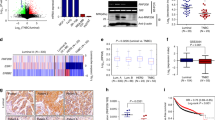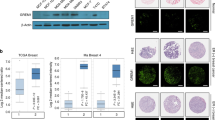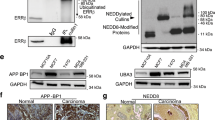Abstract
Oestrogen exerts its influence on target organs through activating oestrogen receptors (ERs) and regulating downstream genes by means of their oestrogen-responsive elements. Efp, a target gene product of ERα1,2,3, is a member of the RING-finger B-box coiled-coil (RBCC) motif family4. Efp is predominantly expressed in various female organs2 as well as in breast cancers5, and is thought to be essential for oestrogen-dependent cell proliferation and organ development—Efp-disrupted mice display underdeveloped uteri and reduced oestrogen responsiveness6. Here we show that Efp is a RING-finger-dependent ubiquitin ligase (E3) that targets proteolysis of 14-3-3σ, a negative cell cycle regulator that causes G2 arrest7. We demonstrate that tumour growth of breast cancer MCF7 cells implanted in female athymic mice is reduced by treatment with antisense Efp oligonucleotide. Efp-overexpressing MCF7 cells in ovariectomized athymic mice generate tumours in the absence of oestrogen. Loss of Efp function in mouse embryonic fibroblasts results in an accumulation of 14-3-3σ, which is responsible for reduced cell growth. These data provide an insight into the cell-cycle machinery and tumorigenesis of breast cancer by identifying 14-3-3σ as a target for proteolysis by Efp, leading to cell proliferation.
This is a preview of subscription content, access via your institution
Access options
Subscribe to this journal
Receive 51 print issues and online access
$199.00 per year
only $3.90 per issue
Buy this article
- Purchase on Springer Link
- Instant access to full article PDF
Prices may be subject to local taxes which are calculated during checkout





Similar content being viewed by others
References
Inoue, S. et al. Genomic binding-site cloning reveals an estrogen-respomsive gene that encodes a RING finger protein. Proc. Natl Acad. Sci. USA 90, 11117–11121 (1993)
Orimo, A., Inoue, S., Ikeda, K., Noji, S. & Muramatsu, M. Molecular cloning, structure, and expression of mouse estrogen-responsive finger protein Efp. Co-localization with estrogen receptor mRNA in target organs. J. Biol. Chem. 270, 24406–24413 (1995)
Muramatsu, M. & Inoue, S. Estrogen receptors: how do they control reproductive and non-reproductive functions. Biochem. Biophys. Res. Commun. 270, 1–10 (2000)
Freemont, P. S. RING for destruction? Curr. Biol. 10, R84–R87 (2000)
Ikeda, K., Orimo, A., Higashi, Y., Muramatsu, M. & Inoue, S. Efp as a primary estrogen-responsive gene in human breast cancer. FEBS Lett. 472, 9–13 (2000)
Orimo, A. et al. Underdeveloped uterus and reduced estrogen responsiveness in mice with disruption of the estrogen-responsive finger protein gene, which is a direct target of estrogen receptor. Proc. Natl Acad. Sci. USA 96, 12027–12032 (1999)
Hermeking, H. et al. 14-3-3 σ is a p53-regulated inhibitor of G2/M progression. Mol. Cell 1, 3–11 (1997)
Bunz, F. et al. Requirement for p53 and p21 to sustain G2 arrest after DNA damage. Science 282, 1497–1501 (1998)
Prasad, G. L., Valverius, E. M., McDuffie, E. & Cooper, H. L. Complementary DNA cloning of a novel epithelial cell marker protein, HME1, that may be down-regulated in neoplastic mammary cells. Cell Growth Differ. 3, 507–513 (1992)
Jensen, K., Shiels, C. & Freemont, P. S. PML protein isoforms and the RBCC/TRIM motif. Oncogene 20, 7223–7233 (2001)
Le Douarin, B. et al. The N-terminal part of TIF1, a putative mediator of the ligand-dependent activation function (AF-2) of nuclear receptors, is fused to B-raf in the oncogenic protein T18. EMBO J. 14, 2020–2033 (1995)
Traenckner, E. B., Wilk, S. & Baeuerle, P. A. A proteasome inhibitor prevents activation of NF-κB and stabilizes a newly phosphorylated form of IκB-α that is still bound to NF-κB. EMBO J. 13, 5433–5441 (1994)
Skowyra, D. et al. Reconstitution of G1 cyclin ubiquitination with complexes containing SCFGrr1 and Rbx1. Science 284, 662–665 (1999)
Kamura, T. et al. Rbx1, a component of the VHL tumour suppressor complex and SCF ubiquitin ligase. Science 284, 657–661 (1999)
Ruffner, H., Joazeiro, C. A., Hemmati, D., Hunter, T. & Verma, I. M. Cancer-predisposing mutations within the RING domain of BRCA1: loss of ubiquitin protein ligase activity and protection from radiation hypersensitivity. Proc. Natl Acad. Sci. USA 98, 5134–5139 (2001)
Joazeiro, C. A. et al. The tyrosine kinase negative regulator c-Cbl as a RING-type. E2-dependent ubiquitin-protein ligase. Science 286, 309–312 (1999)
Honda, R. & Yasuda, H. Association of p19 (ARF) with Mdm2 inhibits ubiquitin ligase activity of Mdm2 for tumour suppressor p53. EMBO J. 18, 22–27 (1999)
Shimura, H. et al. Familial Parkinson disease gene product, parkin, is a ubiquitin-protein ligase. Nature Genet. 25, 302–305 (2000)
Trockenbacher, A. et al. MID1, mutated in Opitz syndrome, encodes an ubiquitin ligase that targets phosphatase 2A for degradation. Nature Genet. 29, 287–294 (2001)
Tyers, M. & Willems, A. R. One ring to rule a superfamily of E3 ubiquitin ligases. Science 284, 601–604 (1999).
Joazeiro, C. A. P. & Weissman, A. M. RING finger proteins: mediators of ubiquitin ligase activity. Cell 102, 549–552 (2000)
Pagano, M. et al. Role of the ubiquitin-proteasome pathway in regulating abundance of the cyclin-dependent kinase inhibitor p27. Science 269, 682–685 (1995)
Pickart, C. M. Mechanisms underlying ubiquitination. Annu. Rev. Biochem. 70, 503–533 (2001)
Chan, T. A., Hermeking, H., Lengauer, C., Kinzler, K. W. & Vogelstein, B. 14-3-3σ is required to prevent mitotic catastrophe after DNA damage. Nature 401, 616–620 (1999)
Laronga, C., Yang, H. Y., Neal, C. & Lee, M. H. Association of the cyclin- dependent kinases and 14-3-3σ negatively regulates cell cycle progression. J. Biol. Chem. 275, 23106–23112 (2000)
Kastan, M. B. et al. A mammalian cell cycle checkpoint pathway utilizing p53 and GADD45 is defective in ataxia-telangiectasia. Cell 71, 587–597 (1992)
Cox, L. S. & Lane, D. P. Tumour suppressors, kinases and clamps: how p53 regulates the cell cycle in response to DNA damage. Bioessays 17, 501–508 (1995)
Dellambra, E. et al. Downregulation of 14-3-3σ prevents clonal evolution and leads to immortalization of primary human keratinocytes. J. Cell Biol. 149, 1117–1129 (2000)
Kim, D. W., Uetsuki, T., Kaziro, Y., Yamaguchi, N. & Sugano, S. Use of the human elongation factor 1 α promoter as a versatile and efficient expression system. Gene 91, 217–223 (1990)
Urano, T. et al. p57(Kip2) is degraded through the proteasome in osteoblasts stimulated to proliferation by transforming growth factor-β1. J. Biol. Chem. 274, 12197–12200 (1999)
Acknowledgements
We thank H. Yashiroda, A. Takada, K. Okamoto, M. Kabayashi, S. Inada and T. Hishinuma for technical assistance, and B. Blumberg and K. Horie for critical reading and comments on the manuscript. This work was supported in part by grants-in-aid from the Ministry of Health, Labor and Welfare, from the Ministry of Education, Culture, Sports, Science and Technology of Japan.
Author information
Authors and Affiliations
Corresponding author
Ethics declarations
Competing interests
The authors declare that they have no competing financial interests.
Rights and permissions
About this article
Cite this article
Urano, T., Saito, T., Tsukui, T. et al. Efp targets 14-3-3σ for proteolysis and promotes breast tumour growth. Nature 417, 871–875 (2002). https://doi.org/10.1038/nature00826
Received:
Accepted:
Issue Date:
DOI: https://doi.org/10.1038/nature00826
This article is cited by
-
Suppression of ITPKB degradation by Trim25 confers TMZ resistance in glioblastoma through ROS homeostasis
Signal Transduction and Targeted Therapy (2024)
-
TRIM25 activates AKT/mTOR by inhibiting PTEN via K63-linked polyubiquitination in non-small cell lung cancer
Acta Pharmacologica Sinica (2022)
-
Using a machine learning approach to identify key prognostic molecules for esophageal squamous cell carcinoma
BMC Cancer (2021)
-
LY6K-AS lncRNA is a lung adenocarcinoma prognostic biomarker and regulator of mitotic progression
Oncogene (2021)
-
circNDUFB2 inhibits non-small cell lung cancer progression via destabilizing IGF2BPs and activating anti-tumor immunity
Nature Communications (2021)
Comments
By submitting a comment you agree to abide by our Terms and Community Guidelines. If you find something abusive or that does not comply with our terms or guidelines please flag it as inappropriate.



